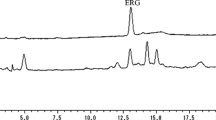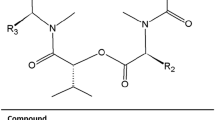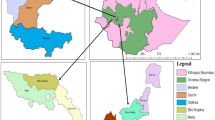Abstract
The deoxynivalenol concentrations found in forage maize ranged between 0.24 and 14.29 mg/kg DM (detected by ELISA). When highly contaminated samples were analysed for deoxynivalenol by HPLC or LC-MS the resulting concentrations were in the mean about 50% lower. Furthermore, using LC-MS other type-A and type-B trichothecenes, zearalenone and α-zearalenol were found in these samples. The differences between ELISA and HPLC/LC-MS data for deoxynivalenol are assumed to result from cross-reactions of other trichothecenes with the antibodies used in ELISA and toxin losses from sample purification procedures needed for HPLC and LC-MS analysis.
Similar content being viewed by others
References
Dänicke S, Gareis M, Bauer J (2001) Orientation values for critical concentrations of deoxynivalenol and zearalenone in diets for pigs, ruminants and gallinaceous poultry. Proc Soc Nutr Physiol 10: 171–174
Ellner FM (2000) Occurrence ofFusarium toxins in the 1999's harvest. Mycotoxin Research 16: 21–25
Krska R, Baumgartner S, Josephs R (2001) The state-of-the-art in the analysis of type-A and-B-trichothecene mycotoxins in cereals. Fresenius J Anal Chem 371, 285–299
Lew H, Adler A, Brodacz W, Edinger W (1997) Zum Vorkommen von Nivalenol in Getreide und Mais. Proceedings 19. Mykotoxin-Workshop, München 2.–4. Juni 1997: 6–9
Lew H, Adler A, Edinger W, Brodacz W, Kiendler E, Hinterholzer J (2001) Fusarien und ihre Toxine bei Mais in Österreich. Bodenkultur 52 (3), 199–207
Oldenburg E (1993) Occurrence of zearalenone in maize. Mycotoxin Research 9: 72–78
Oldenburg E, Lepschy J, Valenta H, Weissbach F (1996) Fusarientoxine in Silomais — Abhängigkeit von Sorte und Standort. Proceedings 18. Mykotoxin-Workshop, Kulmbach, 10.–12. Juni 1996: 174–179
Schollenberger M, Müller H-M, Drochner W (2004): Fusarientoxingehalte in Mais und Produkten auf Maisbasis. Tagungsband 26. Mykotoxin-Workshop, 17.–19. Mai 2004, Herrsching, Schriftenreihe der Bayerischen Landesanstalt für Landwirtschaft 3, 93
Valenta H, Dänicke S, Wolf J (2002) Vergleich einer HPLC- und einer ELISA-Methode zur Bestimmung von Deoxynivalenol in Mühlenstäuben, Kleien und Getreide. VDLUFA-Schriftenreihe 58, 675–679
Author information
Authors and Affiliations
Corresponding author
Rights and permissions
About this article
Cite this article
Oldenburg, E., Ellner, F. Fusarium mycotoxins in forage maize — Detection and evaluation. Mycotox Res 21, 105–107 (2005). https://doi.org/10.1007/BF02954430
Issue Date:
DOI: https://doi.org/10.1007/BF02954430




